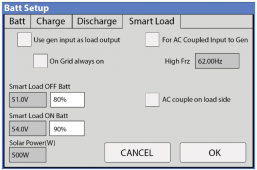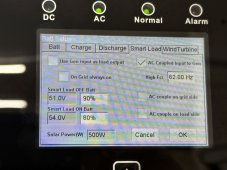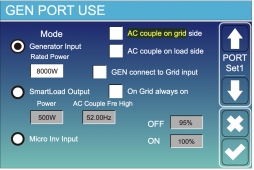I'll chime in here as I have a Sol-Ark 15K with an AC-Coupled portion of my panels tied into the gen terminals.
Notice, the settings for the SmartLoad (ie Gen) terminals are under the battery setup.

The way this handles my SMAs are that upon grid failure {if my batteries are above the Smart Load OFF Batt setting}, it immediately opens the relay and/or bumps the freq to 62 Hz and kills the AC-Coupled inverters. The SMAs can easily shut down fast enough, but what I don't know is if the Sol-Ark has to dump power to the batteries in the process. Also, the DC-coupled solar keeps on trucking (albeit possibly curtailed depending on house load). If the battery level drops below the Smart Load ON Batt setting, the relay closes for the Gen breaker and the SMAs begin their 5-min countdown until they begin producing again. If the grid returns anytime the AC-coupled inverters are disconnected, the Sol-Ark will close the relay and the SMAs will again perform the 5-min countdown before resuming PV production. As far as the SMAs know, the grid failed and therefore UL1741 means I must hold back.
Now, I know Enphase can do fancy stuff with the microinverters as far as limiting export, but I'm not sure how the Sol-Ark can handle that on the Gen port. Especially not without batteries to buffer the power. And how would the Enphase inverters handle the UL1741 countdown? If the Sol-Ark opened the Gen port relay, I would assume Enphase would assume the grid failed as well.
In summary:
Notice, the settings for the SmartLoad (ie Gen) terminals are under the battery setup.

The way this handles my SMAs are that upon grid failure {if my batteries are above the Smart Load OFF Batt setting}, it immediately opens the relay and/or bumps the freq to 62 Hz and kills the AC-Coupled inverters. The SMAs can easily shut down fast enough, but what I don't know is if the Sol-Ark has to dump power to the batteries in the process. Also, the DC-coupled solar keeps on trucking (albeit possibly curtailed depending on house load). If the battery level drops below the Smart Load ON Batt setting, the relay closes for the Gen breaker and the SMAs begin their 5-min countdown until they begin producing again. If the grid returns anytime the AC-coupled inverters are disconnected, the Sol-Ark will close the relay and the SMAs will again perform the 5-min countdown before resuming PV production. As far as the SMAs know, the grid failed and therefore UL1741 means I must hold back.
Now, I know Enphase can do fancy stuff with the microinverters as far as limiting export, but I'm not sure how the Sol-Ark can handle that on the Gen port. Especially not without batteries to buffer the power. And how would the Enphase inverters handle the UL1741 countdown? If the Sol-Ark opened the Gen port relay, I would assume Enphase would assume the grid failed as well.
In summary:
- AC-coupling appears to need the battery. If no battery, just land it on the grid side.
- Sol-Ark has no ability to throttle AC-coupled
- AC-coupling is nice and provides redundancy, but DC-to-DC is much betterer {of my 18kw, ~12kw is DC-coupled}
Last edited:




